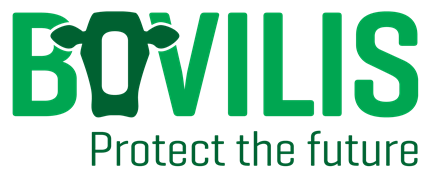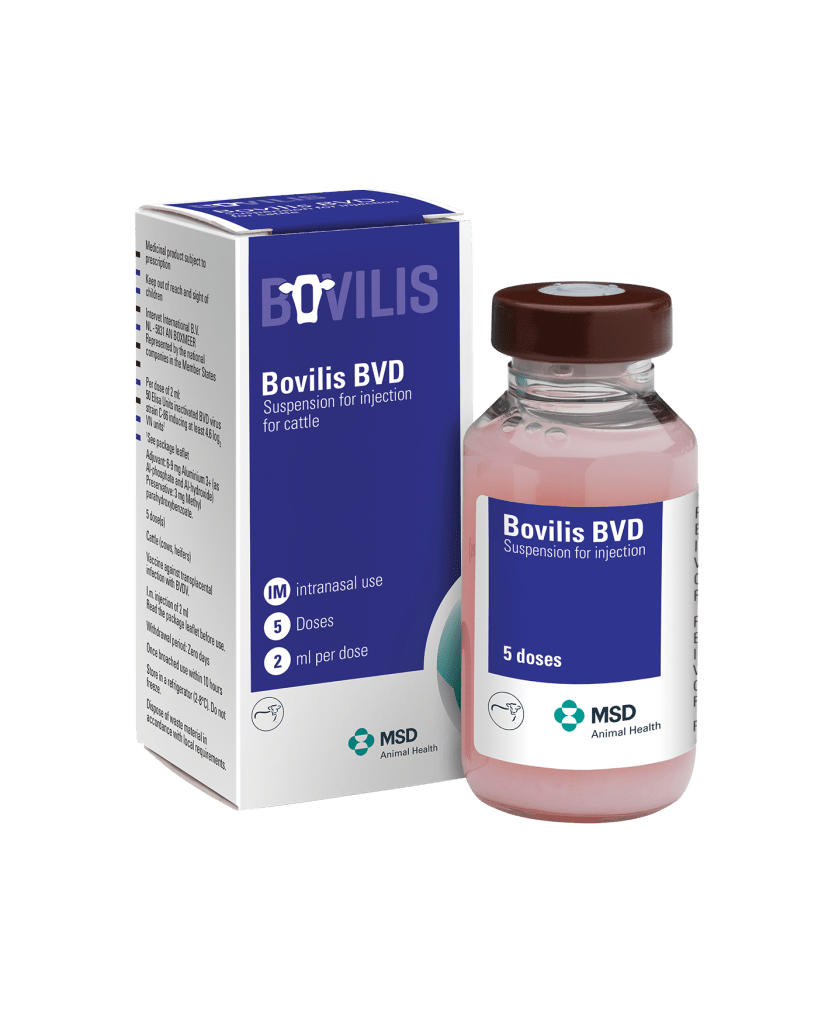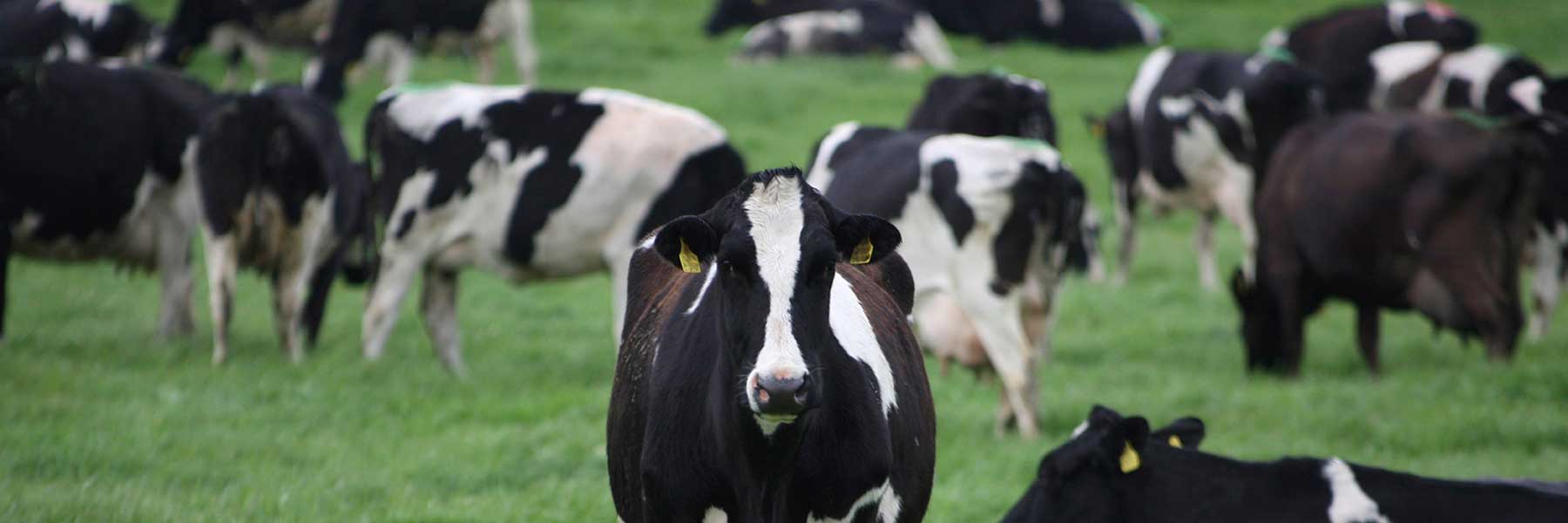

Bovine Viral Diarrhoea (BVD)
Bovilis® BVD
Bovine Viral Diarrhoea in Cattle
Bovine viral diarrhoea is a highly infectious disease caused by a virus transmitted from infected animals. Animal Health Ireland estimate the annual cost of BVD to Irish herds totals €102 million.
In 2013 there were 13 ,995 BVD persistently infected animals identified in Ireland through the National Eradication Scheme. In 2014 there were over 9,500 PI calves identified. Progress has been made towards eradicating BVD with the implementation of a compulsory eradication programme in Ireland. Results of ear notch testing for 2016 indicate that 99.2% of calves tested for BVD virus were negative. However, 4,510 BVD persistently infected (PI) calves were born in this timeframe in 2016, in over 2,500 herds, and are scattered geographically all over the country.
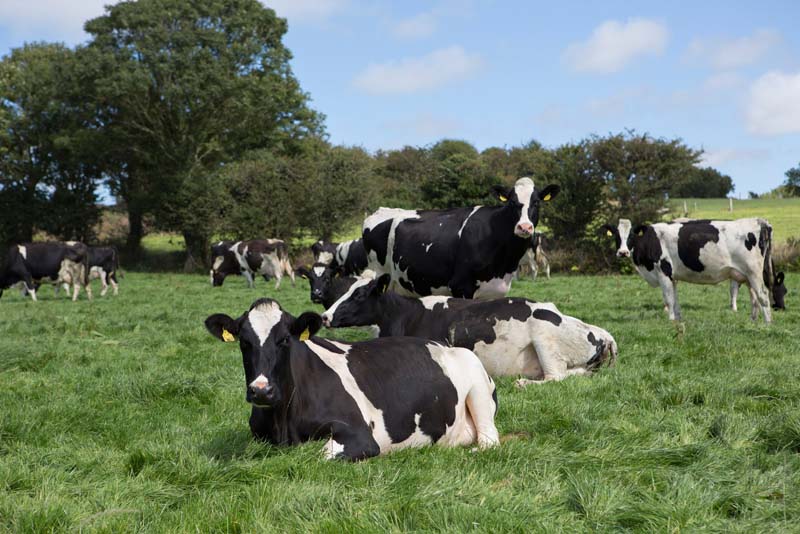
Spread of BVD virus
This mainly occurs by nose-to-nose contact between infected cattle within the herd. Contact with infected animals from neighbouring farms, at marts or shows and during transport facilitates spread. Animals can be infected indirectly by exposure to contaminated equipment, other species including sheep or by visitors to the farm.
What is a persistently infected (PI) animal?
Persistent infection occurs when a dam is infected with BVD for the first time during the first 4 months of pregnancy. Her developing calf can be born persistently infected with the virus and sheds high levels of virus thereafter. Persistently infected animals (PI) may appear normal but are a significant source of infection on farms. PI’s test virus positive at all times. If PI cows become pregnant they will give birth to PI calves.
What is a transiently infected (TI) animal?
Acute or transient infection occurs when an animal becomes infected at any time after it is born. Often this infection is not associated with any obvious signs. When animals are transiently infected with BVD their immune system recognises the disease and responds by producing antibodies. Transiently infected (TI) animals test virus positive at the time of infection but become virus negative within 3 weeks after infection. Once TI animals become clear of the virus they are no longer a threat to the rest of the herd. The majority of PI animals are born to cows which were transiently infected in the first 4 months of pregnancy. Hence the importance of protecting dams against infection during pregnancy by vaccination.
Why do I need to vaccinate if I am testing all calves and removing PI’s?
Removal of PI animals will decrease the amount of virus circulating within the herd. Virus can remain circulating within the herd via transiently infected animals after a PI animal is removed. Importantly, if cows are not protected during pregnancy, transient infection during the first 4 months of pregnancy can result in the birth of future PI calves. The most effective approach to BVD control within the herd is to test and eradicate PI carriers, vaccinate to protect pregnant cows and be vigilant regarding biosecurity. Herds which have retained PI animals are a major threat to neighbouring herds’ disease control.
Why do I need to vaccinate if I am testing all calves and removing PI’s?
BVD control is based on 4 pillars
- Remove PI’s from herd
- Maintain a high level of biosecurity
- Monitor your herd to ensure it stays clear of circulating virus
- Vaccinate with Bovilis BVD
Removal of carrier animals as soon as possible after identification is essential if a herd is to become clear of disease. Monitoring purchased stock for the presence of virus is necessary to prevent the purchase of carrier animals. Due to the high risk of infection in this country it is important that animals are protected until BVD is eradicated. Vaccination of cows and heifers prior to the breeding season every year is advised to protect against the effects of BVD infection during pregnancy.
Protecting the foetus
Once Pls have been identified and removed, it is crucial to try and prevent the BVD virus working its way back into the breeding herd. In a country with high cattle movements and generally sub-optimal levels of biosecurity, vaccination has an important role to play. Since Pls result from infection of the foetus in early gestation, the aim of vaccination is to have maximum levels of immunity at this vital stage in order to protect the foetus against transplacental infection. Bovilis BVD is licensed for 12 Month Foetal Protection*
Vaccination programme
Bovilis BVD is licensed for use in cows and heifers from 8 months old to protect the foetus from infection with BVD virus via the placenta. A primary vaccination course, commencing after 8 months of age, requires 2 doses of Bovilis BVD given by intramuscular injection four weeks apart. Ideally the vaccination course is completed a month before the start of the breeding season. Booster vaccination in following seasons requires a single dose of Bovilis BVD 4 weeks before the start of the next pregnancy. Conveniently, Leptavoid H can be given at the same time as Bovilis BVD to cows and heifers thereby protecting against both BVD and leptospirosis.
Bovilis BVD and Bovilis IBR Marker Live vaccines can be used in combination as a booster dose in cattle from 15 months old. Bovilis BVD and Bovilis IBR Marker Live should be used separately when administering the primary vaccine against BVD and IBR. These vaccines can be mixed together and given in a single 2ml intramuscular injection for booster doses. Less crush time means less stress on man and beast!
*One vaccination 6 months after basic vaccination course with next re-vaccination at an interval no greater than 12 months.
Product Focus
Related Video
To activate the video player please allow cookies in category ‘Performance and Operation’ and refresh this page.
Related Articles
- Technology for Profit competition #TimeForTech
 We’re looking for Irelands most innovative dairy farmers! #TimeforTech Following the success of our Prevention for Profit campaign we’re excited to launch the “Technology for Profit” competition for 2025.
We’re looking for Irelands most innovative dairy farmers! #TimeforTech Following the success of our Prevention for Profit campaign we’re excited to launch the “Technology for Profit” competition for 2025. - Flies – Nuisance by name, nuisance by nature
 With temperatures slowly on the rise, next on the agenda – fly season. Impact on production and spread of disease Anyone who has worked with cattle during the summer months needs little reminding of the annoyance which flies can cause. They can be responsible for a state of unrest in the parlour for both cows … Read more
With temperatures slowly on the rise, next on the agenda – fly season. Impact on production and spread of disease Anyone who has worked with cattle during the summer months needs little reminding of the annoyance which flies can cause. They can be responsible for a state of unrest in the parlour for both cows … Read more - Reducing Abortion Rates in Your Flock: Enzootic Abortion of Ewes and Toxoplasmosis
 Eleanor Brady, MVB MRCVS, Ruminant Veterinary Manager, MSD Animal Health Many Irish flocks will experience a few abortions each year, but how many abortions is too many? Targets for abortion and overall empty rate are set at <2% and <5% respectively, although many flock owners accept rates higher than this. Approximately one third of lamb … Read more
Eleanor Brady, MVB MRCVS, Ruminant Veterinary Manager, MSD Animal Health Many Irish flocks will experience a few abortions each year, but how many abortions is too many? Targets for abortion and overall empty rate are set at <2% and <5% respectively, although many flock owners accept rates higher than this. Approximately one third of lamb … Read more

“Animal Health Ireland estimate the annual cost of BVD to Irish herds totals €102 million.”
Sign up to Bovilis® product and event information
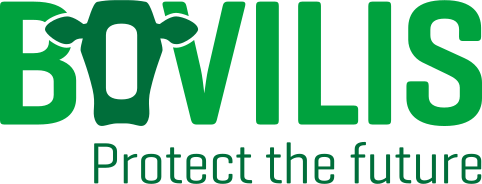
MSD Animal Health
Red Oak North, South County Business Park, Leopardstown,
Dublin 18, Ireland
vet-support.ie@msd.com
PHONE
CATTLE DISEASES
